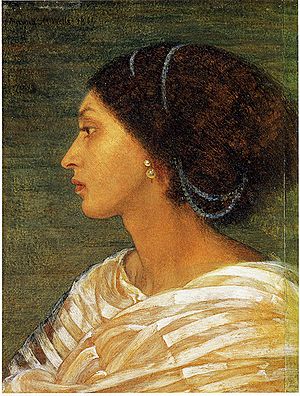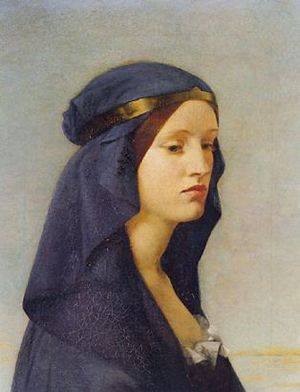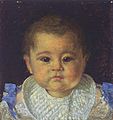Joanna Mary Boyce facts for kids
Joanna Mary Boyce (born December 7, 1831 – died July 15, 1861) was a talented British painter. She was connected to a group of artists called the Pre-Raphaelite Brotherhood. She was also known as Mrs. H.T. Wells after she got married, or as Joanna Mary Wells.
Joanna created many paintings about history, as well as portraits of people and quick sketches. She also wrote about art, sharing her thoughts on other artists' work. Her older brother, George Price Boyce, was also a painter who used watercolours and was part of the Pre-Raphaelite movement.
Contents
Life Story of Joanna Mary Boyce
Early Life and Learning to Paint
Joanna Mary Boyce was born in Maida Vale, London. Her father, George Boyce, used to sell wine and later became a successful pawnbroker. Her mother was Anne.
Joanna's father and her older brother, George Price Boyce, strongly supported her artistic journey. She started learning to draw formally at age eleven with Charles John Mayle Whichelo. She filled many sketchbooks as a teenager.
When she was eighteen, she joined Cary's art academy. After that, she studied with James Mathews Leigh at his school in London. In 1855, she traveled to Paris and studied art there with Thomas Couture.
Her Painting Career
Joanna first showed her artwork to the public in 1855 at the Royal Academy of Arts. She displayed two paintings, but it was her painting called Elgiva that really impressed art critics like John Ruskin and Ford Madox Brown.
In Elgiva, Joanna painted a model named Lizzie Ridley as a sad heroine from an old Anglo-Saxon legend. Another Pre-Raphaelite painter, John Everett Millais, had painted Elgiva eight years earlier. After seeing her painting, John Ruskin praised it. He said that her use of color and imagination showed great power and promise. He believed she could become one of the very best painters if she kept looking at nature and her own ideas for inspiration.
After her first exhibition, Joanna kept working hard to improve her art. She did many sketches and traveled internationally to see art. In 1857, she spent time in Italy. In December of that year, she married Henry Tanworth Wells in Rome. He was a miniaturist, meaning he painted very small, detailed pictures. He later became a Royal Academician himself. While in Italy, Joanna worked on paintings like The Boys' Crusade and La Veneziana, which was a portrait of a lady from Venice.
Besides her own painting, Joanna also spent time looking at and thinking about the art of other painters. She wrote about some of her ideas in a magazine called the Saturday Review. In her writings, she praised the "sincerity" and ideas of the Pre-Raphaelite art movement. She also noted how much John Ruskin had positively influenced the art world in England.

Her Last Years
Some of Joanna's later paintings include Head of a Mulatto Woman. This was a portrait of Fanny Eaton, who was an immigrant from Jamaica and a popular model for many artists.
Joanna Mary Boyce passed away on July 15, 1861, shortly after giving birth to her third child. Her very last completed painting, A Bird of God, was still on her easel when she died.
Joanna Mary Boyce's Legacy
When Joanna died, other artists and writers spoke highly of her talent. Dante Gabriel Rossetti called her "a wonderfully gifted woman". Another writer said she was a genius.
Later art experts have noted that Joanna's fame was limited because she died so young. However, her art has been shown in exhibitions even today. One early show of her work after her death was held at the Tate gallery in 1935.
In 2019, some of Joanna's artworks were shown in London at the National Portrait Gallery. This exhibition was called "Pre-Raphaelite Sisters". It featured portraits by and of important women connected to the Pre-Raphaelite movement. Sadly, not all of Joanna's artworks still exist, as some were destroyed during bombings in World War II.
Even though Joanna is often linked to the Pre-Raphaelite movement, experts have pointed out that she wasn't just a follower. Art historian Pamela Gerrish Nunn noted that critics at the time compared Joanna's work to the old masters from Venice. Writer Simon Poë also observed that her time studying in Paris influenced her art. This brought in ideas from Classical Academic and Romantic art styles.
Gallery
See also
 In Spanish: Joanna Mary Boyce para niños
In Spanish: Joanna Mary Boyce para niños
- Other English women painters from the early 1800s who showed their art at the Royal Academy of Art







